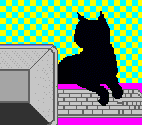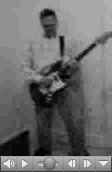Geeks in the Gallery is a three part discussion series on the work of Michael Bell-Smith and Tom Moody, which will run on Art Fag City from Monday June 12 — Wednesday, June 14, 2006. Comments this series are welcome, and will be hosted on Tom Moody’s blog.
If you are just tuning into the interview now, you can read part one of the interview series here, (or just scroll down to the next post).

Image via Cosmic Disciple
Geeks in the Gallery: Part Two
PJ: While everything that has been said thus far makes sense, I have to admit, I'm finding some of it hard to follow in terms of how it is specifically applied to each artist’s work. Let me summarize what has been said thus far, and ask a few questions where I am unclear.
First to sum up Mike’s original comment, our discussion about animated GIFs breaks down into two categories:
1) The influence and/or appropriation of visual imagery on the web to art making
2) The approach of animation that fits in line with early web animation attributes: small sizes, short durations, a lack of sound, looping, tiling, limited color palettes, the “steady state”, and portability (added by Tom)
So sure, these are the approaches and influences that inform the work, but simply putting together something with these principles in mind doesn’t necessarily make engaging work – (I should note here that I understand that you did not suggest that it did in your response). While we may share an interest in early web aesthetics and approach to production, I don’t think we can assume that the viewer remembers or knows what these things are. There has to be more to the work than this to make it engaging – and it seems like this often happens when imagery and concepts have a relation to methods of production. In what ways do you think your work transcends these techy interests? I think to some degree Tom has answered this question when he says that this happens by using a grander size (as with Optidisc).
But when he says “It’s more than just a little looping object on that scale–it becomes aggressive, totalizing,” I would counter that point with the thought that large scale work is something we are accustomed to seeing in the gallery, so I think many of us are dulled to these effects. From my point of view I find the weird guitar solo on the tiny screen at artMovingProjects much more interesting. I mean here is this little screen of a middle aged, bookish man, rocking out (forever, because the movie is looped). I think this is a great contrast to rock boy art, without being glib or simply ironic.
Tom Moody, Guitar Solo [4.5 MB Quicktime video]
Image Courtesy artMovingProjects
Mike, in your response to the context that the gallery brings to the work and pop culture you talk about the relationship and of source material/influence and final products and go on to say,
“I think the more interesting issue is that I’m using technology in a way that facilitates the collaging of these different elements into a cohesive whole.”
This doesn’t make any sense to me. Why is using technology to bring together original and appropriated imagery so engaging? I mean what is interesting to me is that “Focused, Forward” is much greater than the sum of its parts – I don’t really care how those parts came together. Are you telling me I should?
MBS: I’m certainly not telling you you should care. My point was simply that if we’re talking about issues of appropriation (how much comes from XYZ, how much is invented whole cloth), then for me it’s more interesting to talk about that slippage, that gray area, than saying something like “50/50”. By no means do I think I’m breaking new ground by blending new and used with the work in “Focused, Forward” but I do think the way I’m working with these two categories is an outgrowth of new approaches to technology and new attitudes about authenticity and originality that have come from the internet and upload/download culture.
But that’s not to say that those works are ABOUT those issues, in the way that other work of mine – my R Kelly Videos or Blazin’ Blip Blop and Blar & Blee CD cd – might be, but they are certainly an aspect of the work, if not in its reception, then in its creation.

TM: Paddy, can I infer from your questions and comments that you think it’s important for art to have a narrative, and that you don’t like abstract art much?
Guitar Solo, while looping, is linear. The musical notes (created with a sampler and a .wav editor, not a guitar) are paced, they come to a couple of climaxes, and the loop ends when I take off the guitar strap. And then starts again.
The other piece you mentioned, Sensor Readings, “implies a historical narrative” because it’s rooted in the Star Trek industry and fan culture that “the steady state [of the loop] does not escape.” But that piece is also linear. It has a definite beginning (verse-chorus), middle (a drum solo), and end (the chorus jumps an octave and does a fast fade). We set it to loop in the gallery but in my lecture/performance I ran it once.
The other 3/5s of the show consists of abstract or semi-abstract GIFs converted to video. With abstraction the goal is a kind of zen, hypnotic unfolding of simultaneous sense data. One person said he’d looked at OptiDisc for some time before he noticed the irregularities in the spacing of the concentric discs. They were drawn without any reference to a grid, so they’re klutzy and subjective. There is an odd “seam” at the loop point where the target freezes and torques slightly and there is a shuddering, moire effect as the pixels realign. The piece is meant to be big, dumb, and iconic, a moving, pulsing symbol of both the promise and failure of technology.
To return to a couple of points, one thing about Pop is it was also called “overly simple.” I mean, a picture of a soup can, come on! Ditto color field painting: a big Noland target stained on cotton duck, where’s the beef? Ditto minimalism: metal squares on the floor, they’re just not engaging! Or in music–the Ramones, their tunes are so short, shouldn’t there be more complexity?
I can’t make my show float your boat–words help but they’re no substitute for you experiencing something.
PJ: Well, those ideas certainly do float my boat. I hadn’t thought about it in quite those terms, but I definitely see the relationships you’re talking about, and I think they are very important. Mind you, I’m still not sold on the idea of size making the work aggressive. On a related note – since most people don’t seem to make much distinction between net culture and traditional mass media do you think many people will be able to recognize that your response parallels Pop art as opposed to simply repeating it?
On narrative: I think you are right to point out that I have a bias when it comes to this, though I would qualify that with the stipulation that it is continuous narrative that I am most interested in. I like its force…that it can build into something significant even when it is not intended to. However, I wouldn’t say that this means abstraction has little appeal to me or that I think less of art that is without narrative. If I were to nail myself on this sort of thing it would be that I don’t have an interest in abstraction that doesn’t use a formalist aesthetic in some way or have any thought put into it. I don’t like work that lacks consideration, and was some scrap of paper before it was mounted on the wall and had some aggrandized label of “art” slapped on it. That’s boring.
TM: Well, in my case, it’s more than just size and it’s more than just being aggressive. Reactions to the OptiDisc piece vary: some find the projection weirdly calming. It invites playing around; a lot of people lose their inhibitions and “spazz out” in front of it. Also, the conversion of the GIF to video adds colors that aren’t in the original image–you find yourself sorting out how much is actually there and how much is a retinal, “Op art” effect. It’s interactive, even though there’s no joystick or buttons to push. The design originated as my own abstract Internet graphic but as a gallery video, viewers can bring as much or as little “net knowledge” as they want to it.
Look forward to tomorrows concluding post: Geeks in the Gallery Part Three of Three





Comments on this entry are closed.